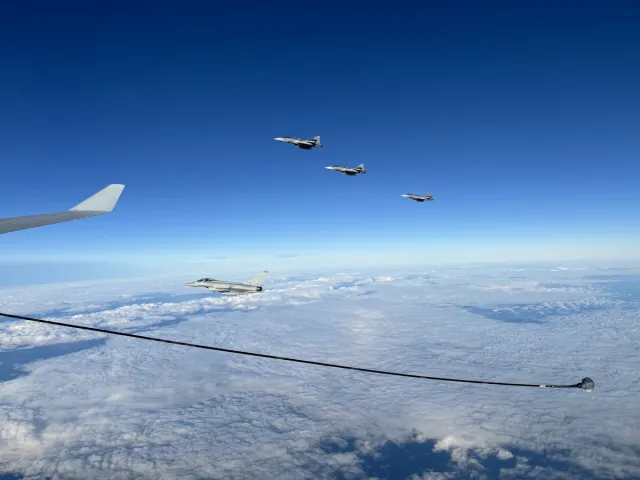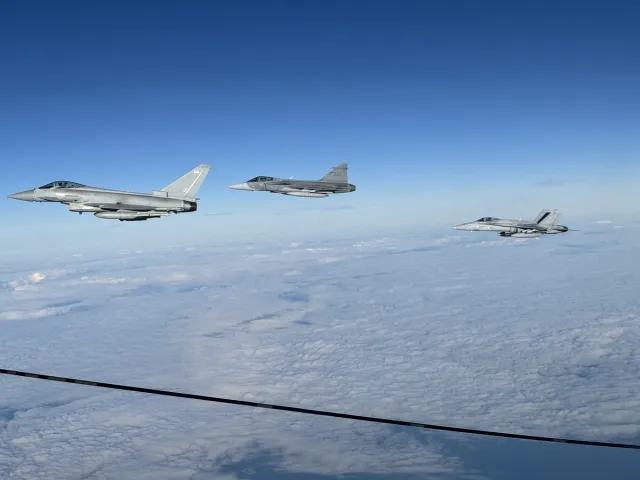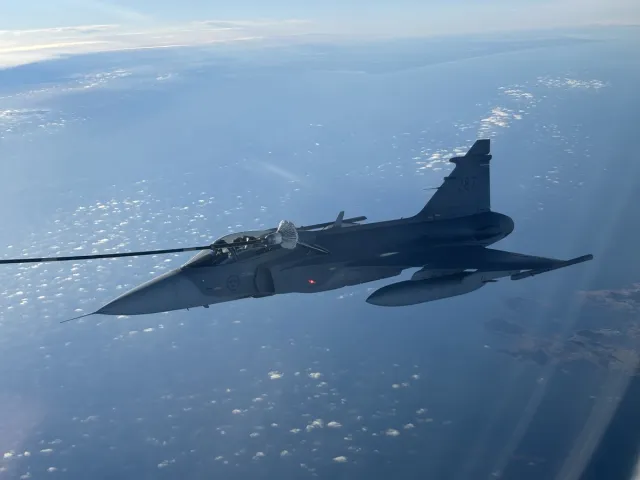-
Andriy Yermak Resigns: What to Know About Ukrainian Official - 14 mins ago
-
How to Watch Georgia vs Georgia Tech: Live Stream NCAA College Football, TV Channel - 33 mins ago
-
Trump’s Response to Shooting Shows Intensified Anti-Migrant Stance - 60 mins ago
-
‘College GameDay’ Makes Big Announcement Before Ohio State-Michigan Game - about 1 hour ago
-
Jonathan Bailey Fans Under Fire Over Comments About His Sexuality - 2 hours ago
-
‘My Baby Girl Has Passed to Glory,’ Says Father of Guard Soldier Killed in D.C. Shooting - 2 hours ago
-
Mets Acquire Ex-White Sox, Yankees Pitcher After 3-Year MLB Hiatus - 2 hours ago
-
A Hong Kong Fire Survivor’s Escape, in His Own Words - 2 hours ago
-
Aldi recall: Customers told discard Christmas products ‘immediately’ - 3 hours ago
-
Officials Had Been Warned for Over a Year Before Hong Kong Fire - 3 hours ago
Watch: NATO Fighter Jets Refuel in Midair Over Eastern Flank
NATO fighter jets from three countries carried out refueling missions on Thursday in exercises linked to the alliance’s push to protect its eastern flank from Russia.
Two British Typhoon jets, four Swedish Gripen aircraft and two Finnish F/A-18s refueled from one of the U.K.’s Royal Air Force (RAF) Voyager tankers as it swept from the country’s Brize Norton base in southern England northward, heading for the Baltic states before returning to British airspace via Poland.
Newsweek was aboard the Voyager, an adapted Airbus A330 300, as it skirted roughly 30 miles from Kaliningrad, Russia’s exclave sandwiched between NATO members Poland and Lithuania.
The bloc announced in September it would beef up its air presence along NATO’s eastern edge, two days after roughly 20 Russian drones crossed over into Poland on September 10. Moscow said at the time it had not deliberately targeted the country, but Polish prime minister, Donald Tusk, said the incident marked “the closest we have been to open conflict since World War Two.”
Drones have frequently crossed into NATO airspace in the close to four years of full-scale war in Ukraine. Two Russian uncrewed aerial vehicles (UAVs) violated Romanian airspace early Tuesday, six days after another drone traveled roughly five miles into the NATO country’s territory.

The incursions have not, so far, been treated as deliberate attacks on the alliance, which could trigger NATO’s Article 5. Under this part of its founding treaty, all members of the bloc are to treat an attack on one state as an attack on all. Poland triggered Article 4 in September, meaning the alliance comes together to discuss “whenever, in the opinion of any of them, the territorial integrity, political independence or security of any of the Parties is threatened.”
Estonia separately triggered Article 4 after it said Russian fighter jets had violated its airspace in an incident in late September. Russia said its three MiG-31 missile-carrying supersonic jets had not infringed on NATO airspace en route to Kaliningrad.
The Voyager tanker did not report any GPS interference close to Russian soil in Kaliningrad on Thursday. Civilian and military aircraft have been plagued by extensive interference with aircraft navigation systems in recent years, the finger often pointed at Moscow. A plane carrying European Commission chief Ursula von der Leyen was smacked with GPS interference in September, and an aircraft carrying Spain’s defense minister separately experienced attempted navigation meddling weeks later, officials said.

Voyagers are not typically equipped with specific electronic warfare (EW) countermeasures to fend off the likes of GPS interference. When asked how the air-to-air refueling tanker deals with EW, the missions systems operator onboard remarked: “We don’t.”
But the flight will have been watched by the Russians, one of the Voyager pilots said. Refueling aircraft are occasionally, but rarely, intercepted.
‘Essential’ Aircraft
Less glamorous than the six fighter jets that latched onto an air refueling hose, the Voyager is still an “essential” part of keeping NATO air operations up and running, the missions systems operator said.
Fighter jets like the Typhoons deployed from the U.K. can only travel for a few hours before they burn through much of their fuel supplies. But each Voyager can carry 109 tons of fuel, filling a Typhoon tank back up in roughly 10 minutes.

Typhoons rarely travel without a Voyager, those onboard said. To go without would seriously limit the distance the jets can cover.
British Typhoons carried out their first Eastern Sentry sortie on September 21. Denmark has put forward two of its F-16 fighter jets and an anti-air warfare ship for the effort. France has contributed three of its Rafales and Germany four of its own Typhoons.
NATO already had several air policing missions up and running before September. Two German Typhoon aircraft were scrambled to defend Romania’s airspace this week.
RAF Typhoons wrapped up their own air policing mission in Poland in July. The British jets were joined by Swedish Gripen jets at the Malbork air base in northern Poland.
Since Russian tanks rolled over into Ukraine in early 2022, NATO officials and agencies have turned up the volume on their warnings about when the Kremlin could opt to take a bite out of a NATO nation, most likely from Estonia, Latvia or Lithuania. Estimations for when Russia could launch an armed attack on these countries vary, from a handful of months to before the end of the decade.
Sweden and Finland both joined NATO after Russia launched its full-scale invasion. One of the pilots on the Voyager’s flight deck said there had been a marked mentality shift since 2022 and sorties had become increasingly complex.
“There’s been a change, all right,” he added.
Source link



















